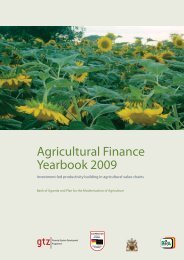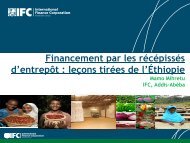Innovations in Rural and Agriculture Finance
Innovations in Rural and Agriculture Finance
Innovations in Rural and Agriculture Finance
You also want an ePaper? Increase the reach of your titles
YUMPU automatically turns print PDFs into web optimized ePapers that Google loves.
<strong>Rural</strong> leas<strong>in</strong>g <strong>in</strong>itiativesA 2006 World Bank case study of three profitable providers ofleas<strong>in</strong>g <strong>in</strong> rural areas showed that <strong>in</strong> all three cases the ruralportfolios were as profitable as their urban portfolios. ArrendadoraJohn Deere, the largest provider of farm mach<strong>in</strong>ery leases <strong>in</strong> Mexico,had nearly US$63 million <strong>in</strong> farm equipment leases. DFCU Leas<strong>in</strong>g,the largest provider of leases <strong>in</strong> Ug<strong>and</strong>a, had a US$5 million leaseportfolio <strong>in</strong> rural areas. Network Leas<strong>in</strong>g Corporation Limited, alead<strong>in</strong>g micro-leas<strong>in</strong>g provider <strong>in</strong> Pakistan, had a lease portfolio ofmore than US$2.4 million <strong>in</strong> rural areas. Low lease losses, strongclient dem<strong>and</strong> for asset f<strong>in</strong>anc<strong>in</strong>g, <strong>and</strong> a favorable legal <strong>and</strong> policyenvironment made rural leas<strong>in</strong>g a profitable bus<strong>in</strong>ess for thesecompanies. For clients, access to f<strong>in</strong>ance at a reasonable cost, low orno collateral requirements, quick process<strong>in</strong>g, <strong>and</strong> easy access to theprovider appear to be significant benefits.Draw<strong>in</strong>g on the experiences of the providers studied, the WorldBank study identified the follow<strong>in</strong>g lessons on manag<strong>in</strong>g f<strong>in</strong>ancialleas<strong>in</strong>g <strong>in</strong> rural areas.• <strong>Rural</strong> leas<strong>in</strong>g is a means to acquire productive assets.All rural leases provided by the three leas<strong>in</strong>g companies aref<strong>in</strong>ancial leases <strong>and</strong> were used to f<strong>in</strong>ance the acquisition ofassets (<strong>in</strong> contrast to rent<strong>in</strong>g of assets).• <strong>Rural</strong> enterprises of different sizes benefit from leas<strong>in</strong>g,but a provider may not be able to equally serve allenterprises. Providers are limited because of differences <strong>in</strong> theskills <strong>and</strong> capacities required to effectively serve enterprises ofvary<strong>in</strong>g sizes.• Nonfarm enterprises account for a significant proportionof rural leases.• <strong>Rural</strong> leas<strong>in</strong>g can be profitable, but jump-start<strong>in</strong>g ruralleas<strong>in</strong>g will require government <strong>and</strong> donor support. Allthree firms studied benefited from access to government ordonor funds, particularly <strong>in</strong> exp<strong>and</strong><strong>in</strong>g their rural operations.• A rural-only leas<strong>in</strong>g company may not be viable. Becauseleas<strong>in</strong>g is a specialized f<strong>in</strong>ancial activity, economies of scale,cost, <strong>and</strong> risk factors may require that, <strong>in</strong> most economies,leas<strong>in</strong>g companies have larger urban operations.The challenge: Support<strong>in</strong>g <strong>in</strong>creased availabilityof leas<strong>in</strong>g <strong>in</strong> rural areasLeas<strong>in</strong>g is a viable tool to f<strong>in</strong>ance rural assets. The nature <strong>and</strong>capacity of exist<strong>in</strong>g f<strong>in</strong>ancial <strong>in</strong>stitutions, the level of potentialdem<strong>and</strong> for <strong>in</strong>vestment f<strong>in</strong>ance <strong>in</strong> rural areas, <strong>and</strong> the levelof development of the leas<strong>in</strong>g <strong>in</strong>dustry should determ<strong>in</strong>e themechanisms for support<strong>in</strong>g <strong>in</strong>creased access to leas<strong>in</strong>g for ruralenterprises. Policy-level support will be required <strong>in</strong> countries that donot have a clear legal <strong>and</strong> regulatory framework for leas<strong>in</strong>g. Suchsupport must be sectorwide <strong>and</strong> not restricted to rural leas<strong>in</strong>g.A good legal framework for leas<strong>in</strong>g <strong>in</strong>cludes (1) clear def<strong>in</strong>itionsof a lease contract, leased assets, <strong>and</strong> responsibilities <strong>and</strong> rights ofthe parties to a lease contract; (2) clarity <strong>in</strong> allocat<strong>in</strong>g responsibilityfor liability for third-party losses aris<strong>in</strong>g out of the operation ofleased assets; (3) stipulation of the priority of a lessor’s claim overa leased asset; <strong>and</strong> (4) a framework for easy <strong>and</strong> fast repossessionof leased assets. The use of <strong>in</strong>ternationally accepted account<strong>in</strong>gst<strong>and</strong>ards <strong>and</strong> an unbiased tax code enhance the developmentof the leas<strong>in</strong>g sector. The existence of a well-function<strong>in</strong>g assetregistry, the availability of <strong>in</strong>surance <strong>and</strong> ma<strong>in</strong>tenance services forequipment at a reasonable cost, <strong>and</strong> the existence of a good marketfor used assets are also necessary for the development of thef<strong>in</strong>ancial leas<strong>in</strong>g <strong>in</strong>dustry.Targeted <strong>in</strong>stitutional support may also be needed to helpdevelop the rural leas<strong>in</strong>g sector. As shown <strong>in</strong> Boxes 1 <strong>and</strong> 2 <strong>and</strong>Figure 1, f<strong>in</strong>ancial leas<strong>in</strong>g is a relatively complex transaction. Tosuccessfully undertake f<strong>in</strong>ancial leas<strong>in</strong>g operations, organizationsneed not only well-tra<strong>in</strong>ed staff, but also high-quality leaseorig<strong>in</strong>ation processes, account<strong>in</strong>g <strong>and</strong> <strong>in</strong>ternal control systems,<strong>and</strong> overall portfolio risk management. Types of <strong>in</strong>stitutionallevelsupport that can help <strong>in</strong>clude (1) subsidies for startup costsof leas<strong>in</strong>g operations to help offset the higher transaction cost<strong>and</strong> risk of operat<strong>in</strong>g <strong>in</strong> rural areas; (2) fund<strong>in</strong>g to establish l<strong>in</strong>ksbetween commercial providers <strong>and</strong> community-based or nonprofitorganizations to <strong>in</strong>crease scale; (3) technical support to leas<strong>in</strong>gcompanies; <strong>and</strong> (4) provision of equity, loans, or guarantees toexp<strong>and</strong> rural outreach.A wide range of organizations—leas<strong>in</strong>g companies, banks,f<strong>in</strong>ancial cooperatives, microf<strong>in</strong>ance organizations, <strong>and</strong> equipmentsell<strong>in</strong>gcompanies—could benefit from such support. Institutionallevelsupport can <strong>in</strong>clude capital support when access to longtermfunds is a critical constra<strong>in</strong>t. Capital support comb<strong>in</strong>ed withtechnical assistance can help leas<strong>in</strong>g firms develop access tosusta<strong>in</strong>able sources of capital. nFor further read<strong>in</strong>g: IFC (International F<strong>in</strong>ance Corporation),Leas<strong>in</strong>g <strong>in</strong> Development: Guidel<strong>in</strong>es for Emerg<strong>in</strong>gEconomies (Wash<strong>in</strong>gton, DC, 2009), available at www.IFC.org; A. Nair <strong>and</strong> R. Kloepp<strong>in</strong>ger-Todd, “Buffalo, Bakeries,<strong>and</strong> Tractors: Cases <strong>in</strong> <strong>Rural</strong> Leas<strong>in</strong>g from Pakistan,Ug<strong>and</strong>a, <strong>and</strong> Mexico” (Wash<strong>in</strong>gton, DC: World Bank,2006), available at www.worldbank.org/rural; A. Nair, R.Kloepp<strong>in</strong>ger-Todd, <strong>and</strong> A. Mulder, “Leas<strong>in</strong>g: An UnderutilizedTool <strong>in</strong> <strong>Rural</strong> F<strong>in</strong>ance,” World Bank Agricultural <strong>and</strong><strong>Rural</strong> Development Discussion Paper No. 7 (Wash<strong>in</strong>gton,DC: World Bank, 2004), available at www.worldbank.org/rural; G. D. Westley, Equipment Leas<strong>in</strong>g <strong>and</strong> Lend<strong>in</strong>g: A Guidefor Micro-F<strong>in</strong>ance, Best Practice Series (Wash<strong>in</strong>gton, DC:Inter-American Development Bank, Susta<strong>in</strong>able DevelopmentDepartment, 2003).Ajai Nair (anair@worldbank.org) is program coord<strong>in</strong>ator of the <strong>Agriculture</strong> F<strong>in</strong>ance Support Facility <strong>in</strong> the <strong>Agriculture</strong> <strong>and</strong> <strong>Rural</strong> Development Department ofthe World Bank. Azeb Fissha, consultant, provided research <strong>and</strong> editorial support.International Food PolicyResearch InstituteSupported susta<strong>in</strong>able solutions by the for CGIAR end<strong>in</strong>g hunger <strong>and</strong> povertywww.ifpri.orgSupported by the CGIARwww.worldbank.orgCopyright © 2010 International Food Policy Research Institute <strong>and</strong> the World Bank. All rights reserved. Contact ifpri-copyright@cgiar.org or pubrights@worldbank.org for permission to republish.







